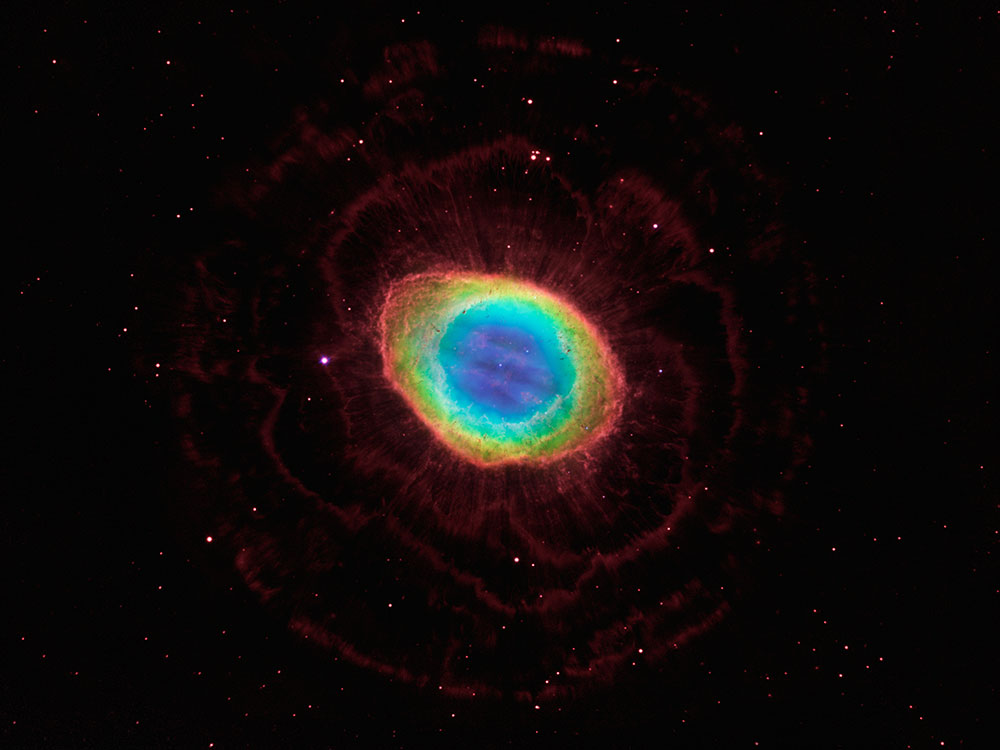ASTRONOMY
ASTRONOMY
ASTRONOMY
ASTRONOMY
ASTRONOMY
Tony Samson and
Looking Closer …
Looking Closer …
Looking Closer …
Looking Closer …
Looking Closer …
Illustrated, the Ring Nebula, NGC6720, M57, by the NASA/ESA Hubble Telescope.
To further improve upon visual observations, we will delve into the use of binoculars in astronomy and take a closer look at the fainter objects in the night sky.
To start with, the strength of binoculars usually start in the 10X50 Class (10 times the magnification and 50mm diameter in lenses) and commercially approach the 25X100 Class. If you are holding the binoculars, we would suggest not to go above the 15X70 Class, as every bump and shake will make it difficult to view a Star, Moon or Satellite. If however, you prefer to mount your binoculars on a tripod, then higher magnifications would be encouraged.
Next to consider is the aperture and the larger the front lenses are, the more light they will let in, therefore, fainter objects will become visible. The lens coatings are an optional and preferred manufacturing process that compensate for flaws in the optical paths and do filter certain wavelengths of light, effectively removing the blue fringe around the object and creating a crisper image.
Start your observations by looking around at the brighter patches of the Milky Way and you will see mostly open star clusters and a few emission nebulae, then, hunt down those fuzzy objects that stand apart from it, the globular star clusters. With a star map or a planetarium phone app, you can then start chasing down some amazing objects such as galaxies. The apparent brightness of an object within the night sky is a term we astronomers call ‘magnitude’ (mag). It is a guide to tell us how faint or bright an object is. The brightest stars start at a range of an apparent magnitude of -1, 0 and 1and further precedes to where the faintest of stars that we can see without viewing aids, at mag 6.5.
So, the fainter an object is, the bigger its magnitude number will be.
With binoculars it is not likely that you will see anything beyond mag 9.5, so when you are planning your viewing session, keep this in mind…
Now for a list of what to chase down.
Butterfly Cluster (mag 5.5 to 7.0)
1, 600 Light Years away.
Open Cluster of Stars.
47 Tuc (mag 4.9)
16, 700 Light Years away.
Globular Cluster in Tucana Constellation.
Small Magellanic Cloud (mag 2.7)
200, 000 Light Years away.
Satellite Dwarf Galaxy.
Large Magellanic Cloud (mag 0.9)
162, 000 Light Years away.
Satellite Galaxy.
Tarantula Nebula (mag 8.0)
159,800 Light Years away..
Diameter of 652 Light Years.
Jewel Box Star Cluster (mag 4.2)
6,440 Light Years away.
Open Cluster of 100 Stars, 3 colours.
Eta Carinae Nebula (mag 1.0)
6,500 Light Years away.
Diameter of 652 Light Years.
Andromeda Galaxy (mag 3.4)
2,500,000 Light Years away.
Spiral Galaxy.
Sculptor Galaxy (mag 8.0)
11,400,000 Light Years away.
Spiral Galaxy.
Helix Nebula (mag 7.6)
700 Light Years away.
Planetary Nebula.
Orion Nebula (mag 4.0)
1,344 Light Years away.
Diffuse Nebula.
Omega Centauri (mag 3.9)
15,800 Light Years away.
Global Cluster (10 million stars).

Veil Nebula, NGC6992 to NGC6995, IC1340, by Robert Bounday
